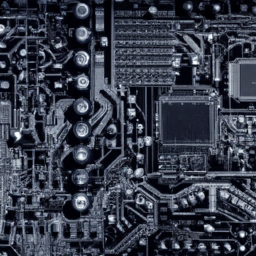How Do IT Services Handle Legacy System Integration?
Are you curious about how IT services handle the integration of legacy systems? This article will give you a brief overview of the methods and strategies used by IT service providers to seamlessly integrate old legacy systems with new and updated technologies. Whether you’re a business owner or a technology enthusiast, understanding the challenges and solutions involved in legacy system integration can help you make informed decisions and ensure a smooth transition. So, let’s dive in and explore the world of IT services and legacy system integration together!
Understanding Legacy Systems
Legacy systems refer to outdated or obsolete software, hardware, or technology that are still in use within an organization. These systems have been in operation for a long time and are often critical to the daily operations of a company. They can be difficult to maintain, update, or integrate with modern technologies due to their age and often lack of vendor support.
Challenges of Legacy Systems
Legacy systems pose a number of challenges that need to be addressed. One of the main challenges is the potential for business disruption if these systems fail or experience issues. As they become older, the risk of failure increases, and finding replacement parts or support can be both time-consuming and costly.
Another challenge is the lack of compatibility with newer technologies. Legacy systems may not be able to communicate or integrate with modern applications, which can limit an organization’s ability to take advantage of new features or innovations. Additionally, legacy systems often suffer from performance issues due to outdated hardware or software limitations.
Importance of Legacy System Integration
Despite their challenges, legacy systems play a vital role in many organizations. They often hold valuable business and customer data that needs to be preserved and integrated with newer systems. Here are some key reasons why legacy system integration is important:
Maintaining Business Continuity
Legacy systems are typically deeply ingrained in an organization’s operations and processes. Upgrading or replacing them entirely can be a complex and disruptive process. By integrating legacy systems with newer technologies, companies can ensure that critical business functions continue to operate smoothly while gradually transitioning to newer platforms.
Cost Efficiency and ROI
Replacing a legacy system outright can be a costly endeavor. Legacy system integration enables organizations to leverage their existing investments and extend the lifespan of these systems. Integration can also help reduce maintenance costs and improve overall return on investment (ROI) by enhancing the functionality and efficiency of the legacy systems.
Enhancing System Functionality
Legacy systems often lack modern features and capabilities. Through integration, organizations have the opportunity to enhance the functionality of these systems by connecting them with newer applications and technologies. By doing so, companies can unlock new capabilities and improve the overall performance of their legacy systems.
Legacy System Integration Approaches
When it comes to integrating legacy systems with modern technologies, there are several approaches that IT services can employ. These approaches include:
Replacement Strategy
In this approach, the legacy system is completely replaced with a modern system. While this can be an effective solution in some cases, it can also be costly, time-consuming, and risky. This approach is best suited for situations where the legacy system is severely outdated or no longer supported by the vendor.
Wrapper Strategy
The wrapper strategy involves surrounding the legacy system with a layer of modern technology that acts as an interface between the legacy system and other applications. This approach enables data exchange and integration between the legacy system and newer systems without the need for extensive modifications to the existing infrastructure.
Database Integration
This approach focuses on integrating the legacy system’s database with newer applications or systems. By connecting the databases, organizations can extract and utilize the valuable data stored in the legacy system while still leveraging the capabilities of modern technologies.
Service-Oriented Architecture (SOA)
SOA involves breaking down the functionality of the legacy system into modular services that can be individually accessed and utilized by other applications. This approach enables easier integration, as these services can be accessed and used by modern technologies without requiring a complete overhaul of the legacy system.
Steps Involved in Legacy System Integration
Integrating legacy systems requires a systematic approach to ensure successful implementation. Consider the following steps:
Evaluation of Legacy System
Before integration, it is important to thoroughly assess the legacy system and understand its overall architecture, functionalities, and limitations. This evaluation will help identify potential integration challenges and determine the most suitable integration approach.
Defining Integration Goals
Clearly articulate the desired outcomes and functionality to be achieved through the integration process. This includes identifying specific business objectives, such as improving data accuracy, streamlining processes, or enhancing user experience.
Identification of Integration Components
Identify the key components that need to be integrated, including databases, applications, and interfaces. This step involves mapping out data flows, identifying dependencies, and determining the necessary integration points.
Data Migration and Cleansing
Once the integration components are identified, the data from the legacy system needs to be migrated to the new system. Additionally, data cleansing may be required to ensure the accuracy and integrity of the data being transferred.
Application Development and Configuration
Develop or configure the necessary applications or interfaces to enable communication and integration between the legacy system and new technologies. This step may involve custom development to create the required functionality or the use of middleware or integration tools.
Potential Challenges and Risks
While legacy system integration offers numerous benefits, there are also potential challenges and risks that need to be considered:
Compatibility Issues
Integrating a legacy system with modern technologies can be complicated due to compatibility issues. Legacy systems may use outdated programming languages or have unique data formats that are not easily compatible with newer systems. Resolving these compatibility issues may require significant effort and expertise.
Lack of Vendor Support
As legacy systems become outdated, it is common for vendors to discontinue support or maintenance. This lack of support can make it difficult to find qualified resources, obtain necessary updates or patches, and resolve issues that may arise during the integration process.
Data Security Concerns
Legacy systems may have vulnerabilities that can expose sensitive data to security risks. Integrating these systems with newer technologies requires careful consideration of data security measures to ensure the protection of critical business information.
Limited Scalability
Legacy systems often have limitations in terms of scalability and capacity. Integration with modern technologies may require addressing these limitations, such as upgrading hardware or reconfiguring the system architecture to accommodate increased data volume or user demand.
Best Practices for Legacy System Integration
To ensure the success of a legacy system integration project, it is important to follow these best practices:
Thorough Analysis and Planning
Perform a comprehensive analysis of the legacy system and the integration requirements before embarking on the project. This analysis should include assessing the system’s current state, identifying integration challenges, and defining clear project goals and deliverables.
Choosing the Right Integration Strategy
Consider the strengths and weaknesses of each integration approach and select the one that best aligns with the organization’s goals and constraints. Consult with IT services or professionals who have experience in legacy system integration to make an informed decision.
Implementing Incremental Changes
Instead of attempting a complete system overhaul, it is often more effective to implement integration in smaller, incremental stages. This allows for easier troubleshooting and minimizes disruptions to the business.
Training and Support for End-Users
To ensure a smooth transition and adoption of the integrated system, provide comprehensive training and ongoing support to end-users. This includes educating users on the new functionalities, processes, and workflows resulting from the integration.
Benefits of Legacy System Integration
Integrating legacy systems with modern technologies can bring several benefits to an organization, including:
Improved Efficiency and Productivity
By integrating legacy systems with newer applications, businesses can streamline processes, reduce manual efforts, and eliminate duplicate data entry. This leads to improved efficiency and productivity, allowing employees to focus on higher-value tasks.
Streamlined Business Processes
Legacy system integration facilitates the exchange of data between different systems, resulting in streamlined and automated business processes. This integration eliminates manual data transfers and reduces the risk of errors, enabling faster and more accurate decision-making.
Real-Time Data Access and Reporting
Integrating legacy systems with modern technologies enables real-time access to critical data and enables accurate and up-to-date reporting. With integrated systems, organizations can quickly generate reports, perform data analysis, and make informed decisions based on real-time information.
Case Studies of Successful Integration
Several companies have successfully integrated their legacy systems and achieved significant benefits. Here are some examples:
Company A: Seamless Integration for Enhanced Performance
Company A, a leading manufacturing company, upgraded their legacy inventory management system by integrating it with a modern Warehouse Management System (WMS). The integration provided real-time visibility of inventory levels, streamlined order fulfillment processes, and improved overall warehouse efficiency.
Company B: Cost Savings and Reduced Downtime
Company B, a financial institution, integrated their legacy core banking system with a new CRM platform. The integration eliminated the need for manual data entry, reduced errors, and improved customer service. The streamlined processes resulted in cost savings and minimized system downtime.
Company C: Achieving Data Visibility across Systems
Company C, a healthcare organization, integrated their legacy Electronic Health Records (EHR) system with a modern data analytics platform. This integration allowed healthcare providers to have a comprehensive view of patient data, resulting in improved treatment outcomes and more informed decision-making.
Considerations for Legacy System Integration Projects
Legacy system integration projects require careful planning and consideration of various factors:
Resource Allocation and Budgeting
Allocate the necessary resources, both in terms of personnel and budget, to ensure the successful completion of the integration project. Consider the expertise required, potential training needs, and any additional hardware or software investments.
Change Management and Communication
Integration projects may bring significant changes to an organization’s processes and workflows. Implement effective change management practices, including clear communication and stakeholder engagement, to ensure smooth adoption and minimize resistance to change.
Testing and Quality Assurance
Thoroughly test the integrated system to identify and address any potential issues or bugs before deploying it in a production environment. This includes conducting both functional and performance testing to ensure that the integrated system meets the required standards and performance expectations.
Future Outlook for Legacy System Integration
As technology evolves, legacy system integration continues to evolve as well. Here are some emerging trends and considerations for the future:
Emerging Technologies and Integration Solutions
Advancements in technologies such as artificial intelligence (AI), machine learning (ML), and robotic process automation (RPA) are expected to play a significant role in legacy system integration. These technologies can automate integration processes, enhance data accuracy, and improve overall system performance.
The Role of Cloud Computing
Cloud computing offers a flexible and scalable platform for legacy system integration. By moving legacy systems to the cloud, organizations can leverage the cloud’s resources and capabilities while integrating with other cloud-based applications and systems.
Addressing Legacy System Obsolescence
As technology continues to advance, the obsolescence of legacy systems becomes an increasingly pressing issue. Organizations will need to carefully consider their options, including complete replacement, modernization, or continued integration efforts to address the challenges associated with outdated systems.
In conclusion, legacy system integration is a critical process for organizations dealing with outdated technology. By leveraging the right integration approaches, following best practices, and addressing potential challenges, businesses can unlock significant benefits such as improved efficiency, streamlined processes, and real-time data access. As technology continues to evolve, organizations must adapt and embrace emerging trends to address legacy system obsolescence and stay ahead in a rapidly changing business landscape.








